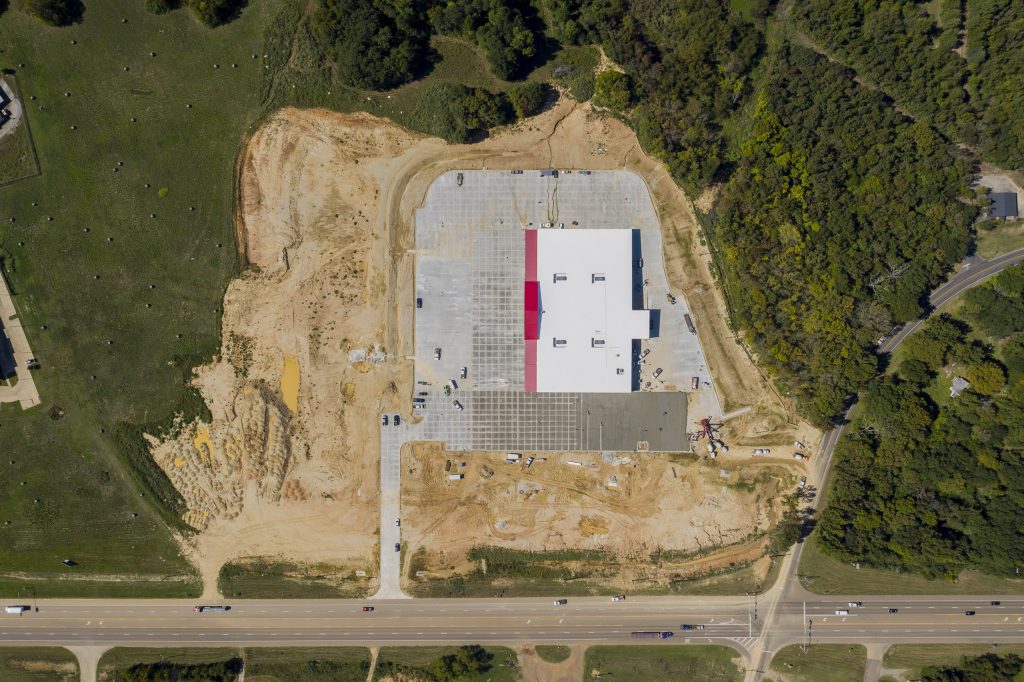Atwoods is nearing completion. Excited for this latest big box to join Mount Pleasant, TX, located across from Lowe’s Home Improvement near Interstate 30. Grand opening coming soon!
Sweet Shop USA Recognized for Helping Pivot to Support the United States COVID Crisis
From Sweet Shop USA: “Sweet Shop was honored in Austin this morning by being invited to meet with the US Surgeon General Jerome Adams and Eric D. Hargan, Deputy Secretary of the Department of Health and Human Services at the offices of the Texas Association of businesses. We were honored to be among a handful of Texas companies recognized for helping pivot to support the United States COVID crisis. Pictured with both men is Mandy Hughes our Chief marketing officer.”
Thank you for going above and beyond to help during these difficult times. Congratulations!
Pilgrim’s to Invest $1.5M in Mount Pleasant
MOUNT PLEASANT, Texas — Building on its ongoing sustainability and social responsibility efforts, Pilgrim’s on Wednesday announced plans to invest $1.5 million in Mount Pleasant, Texas, to support the community’s future and help respond to needs resulting from the coronavirus pandemic.
Pilgrim’s is working with local leaders to identify where the funds can best help meet immediate and longer-term community needs in three key areas: food insecurity, community infrastructure and well-being, and COVID-19 emergency response and relief efforts, according to a Pilgrim’s press release. All projects will be determined by the end of the year. Community members may send suggested proposals for investment to hometownstrong@pilgrims.com.
“The Hometown Strong initiative will allow us to make a tangible impact in our community, which is extremely important to us as a large employer in the area,” said Rapheal Boyd, Pilgrim’s Mount Pleasant Complex Manager. “We believe in collaborating with local leaders and coming together to make a difference.”
“Pilgrim’s Hometown Strong initiative exemplifies what community engagement truly means by showing care and understanding of what this city needs while trying to offset the lasting effects of the global pandemic,” said Mt. Pleasant Mayor Tracy Craig. “I am honored to have the opportunity to collaborate with Pilgrim’s to improve the city of Mount Pleasant.”
The Pilgrim’s Mt. Pleasant prepared foods complex employs 3,200 people with an annual payroll of more than $46 million. The facility supports 290 growers, paying them more than $47 million per year for their livestock. Consistent with its long-term commitment to the local economy, Pilgrim’s Mt. Pleasant has invested nearly $31 million in capital improvements over the last five years.
Pilgrim’s anchors dozens of rural communities — operating more than 30 meat poultry and prepared foods facilities and employing 31,000-plus people in the United States. Nationally, the Hometown Strong initiative is a $20 million investment from Pilgrim’s, which is part of a $50 million nationwide contribution from JBS USA.
Source: Texarkana Gazette
Come Visit and Stay in Beautiful Mount Pleasant, TX
Find out all the great things Mount Pleasant, TX has to offer and why we ![]() Mount Pleasant!!
Mount Pleasant!!
From the Mount Pleasant Chamber of Commerce: “The Chamber and their tourism committee has been working hard with community leaders to showcase all the amazing things that Mount Pleasant, TX has to offer. Thank you to all those who worked behind the scenes to tell the story of Mount Pleasant. There is more to come!”
Titus Regional Medical Center Joint Commission Accredited
You may have seen the Joint Commission Logo on our website or materials and wondered, what is that and what does it mean…
Posted by Titus Regional Medical Center on Wednesday, September 9, 2020
Super proud to live in a quality community with quality healthcare. Congrats Titus Regional Medical Center!
Williams Chicken Opens In Mount Pleasant, TX
Williams Chicken is now open!
Drive-thru only (may open lobby this week)
Address: 815 S Jefferson Ave., Mount Pleasant TX 75455
Hours: 10 a.m. – 10 p.m.
Phone: 903-224-1500 (currently experiencing technical difficulties with phone system)








